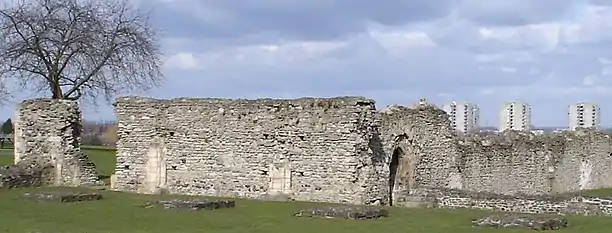Richard de Luci
Richard de Luci (or Lucy; 1089 – 14 July 1179) was first noted as High Sheriff of Essex, after which he was made Chief Justiciar of England.
Richard de Luci | |
|---|---|
| Chief Justiciar of England | |
| In office 1154 – c. September 1178/Easter 1179 | |
| Monarch | Henry II |
| Preceded by | Robert de Beaumont, 2nd Earl of Leicester |
| Succeeded by | Ranulf de Glanvill |
| Sheriff of Essex | |
| In office 1156–1157 | |
| Personal details | |
| Born | 1089 |
| Died | 14 July 1179 Lesnes Abbey, Kent |
| Spouse(s) | Rohese |
| Children | Geoffrey de Luci, Godfrey de Luci, Maud de Luci |
Biography
His mother was Aveline, the niece and heiress of William Goth. In the charter for Séez Cathedral in February 1130/31 Henry I refers to Richard de Luci and his mother, Aveline. His brother, Walter de Luci, was abbot of Battle Abbey. [1]
An early reference to the de Luci family refers to the render by Henry I of the Lordship of Diss, Norfolk to Richard de Luci, Governor of Falaise, Normandy, after defending it with great valour and heroic conduct when besieged by Geoffrey, Earl of Anjou.
In 1153–4 de Luci was granted Chipping Ongar, Essex by William, son of King Stephen and his wife, Maud of Boulogne, where he built Ongar Castle. He was appointed Sheriff of both Essex and Hertfordshire for 1156.

When Henry II came to the throne in 1154, de Luci was made Chief Justiciar of England jointly with Robert de Beaumont, Earl of Leicester. When de Beaumont died in 1168, de Luci continued to hold the office in his own right.[2] One of the members of his household was Roger fitzReinfrid, the brother of Walter de Coutances. Roger became a royal judge and later donated land to Lesnes Abbey in Kent, which had been founded by de Luci.[3]
He resigned his office between September 1178 and Easter of 1179,[2] and retired to Lesnes Abbey, where he died and was buried three months later on 14 July 1179.
De Luci's wife, Rohese, who is named in several documents, was possibly a sister of Faramus de Boulogne.[4] Rohese and Faramus were children of William de Boulogne who was the son of Geoffrey fitz Eustace (son of Eustace II, Count of Boulogne) and Beatrice, daughter of Geoffrey de Mandeville (11th century).
Notes
- Knowles The Monastic Order in England p. 589
- Powicke Handbook of British Chronology p. 69
- Keats-Rohan Domesday Descendants p. 942
- Richardson, D. (2011) Magna Carta Ancestry: A Study ... p. 202 (via Google)
References
- Oxford Dictionary of National Biography
- Powicke, F. Maurice and E. B. Fryde Handbook of British Chronology 2nd. ed. London:Royal Historical Society 1961
- Keats-Rohan, K. S. B. (1999). Domesday Descendants: A Prosopography of Persons Occurring in English Documents, 1066–1166: Pipe Rolls to Cartae Baronum. Ipswich, UK: Boydell Press. ISBN 0-85115-863-3.
External links
- The Lucy & Lucey Family net
- Chisholm, Hugh, ed. (1911). . Encyclopædia Britannica. 17 (11th ed.). Cambridge University Press. p. 111.
- Knowles, Dom David The Monastic Order in England: From the Times of St. Dunstan to the Fourth Lateran Council Second Edition Cambridge: Cambridge University Press 1976 reprint ISBN 0-521-05479-6
| Political offices | ||
|---|---|---|
| Preceded by Robert de Beaumont, 2nd Earl of Leicester |
Chief Justiciar jointly with Robert de Beaumont, 2nd Earl of Leicester 1154 – c. 1179 |
Succeeded by Ranulf de Glanville |